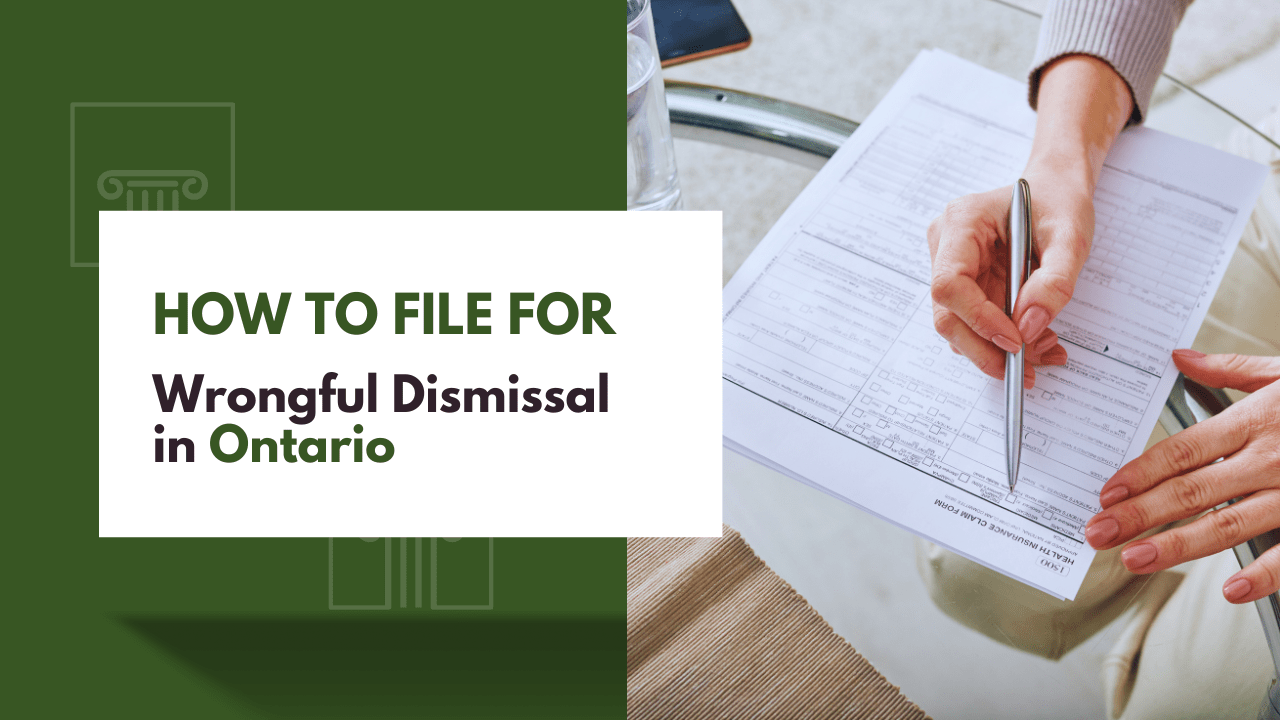
Saad Mirza
Hi! beautiful people. I`m an authtor of this blog. Read our post – stay with us

Saad Mirza
May 14, 2025
How to File for Wrongful Dismissal in Ontario: A Step-by-Step Guide
If you were let go and it doesn’t feel right, it might be wrongful dismissal. I often hear from employees across Ontario who are confused, frustrated, and anxious after being terminated. You’re not alone-and understanding your rights is the first step to protecting them.
What Is Wrongful Dismissal in Ontario?
Wrongful dismissal happens when your employer ends your employment without giving you the notice or compensation required by law or your contract.
In Ontario, this means more than just being fired unfairly; it’s about whether you received proper notice or pay in lieu, as set out under the Employment Standards Act (ESA) and, often, under common law, which can provide even greater protection.
It’s important to distinguish wrongful dismissal from unjust dismissal (a term used mainly for federally regulated employees) and constructive dismissal. Wrongful dismissal is about not receiving proper notice or severance when you’re let go. Constructive dismissal, in contrast, is when your employer makes your job intolerable or changes it so much that you’re forced to quit-something we’ve seen with clients whose hours were cut in half or whose roles were drastically changed without their consent.
Few Examples I See:
• Fired without notice: A client was let go after five years of service with no warning and only two weeks’ pay. This is a classic wrongful dismissal.
• Fired without cause and no severance: Another client was terminated for “restructuring” but received only the ESA minimum, even though their contract didn’t limit their rights to common
law notice.
• Fired for complaining about illegal activity: We’ve helped employees who were dismissed after raising concerns about unpaid overtime or unsafe work conditions-these can be wrongful (and sometimes reprisal) dismissals.
Do You Have a Case? (Eligibility Checklist)
Here’s a quick checklist to help you decide if you might have a wrongful dismissal claim:
• Were you terminated without cause?
• Did your employer fail to give you proper notice or pay in lieu?
• Have you worked at least 3 months?
• Did your employer meet ESA minimums and your common law rights?
• Were you dismissed for exercising a legal right (e.g., complaining about unpaid wages or harassment)?
If you answered “yes” to the first two and have been with your employer for at least three months, you may have a case.
Step-by-Step: How to File a Wrongful Dismissal Claim in Ontario
Step 1: Gather Documentation
Start by collecting all relevant documents:
• Your termination letter
• Employment contract
• Recent pay stubs
• Any emails or communications with your employer about your dismissal
This paperwork forms the backbone of your claim and helps us assess your entitlements.
Step 2: Consult an Ontario Employment Lawyer
Legal advice is crucial. Many employees don’t realize that their rights under common law often exceed ESA minimums-sometimes by a wide margin.
Step 3: Evaluate Legal Options
Depending on your case, we may:
• Draft a demand letter to your employer, outlining your claim and seeking fair compensation
• Enter into settlement negotiations (most cases settle out of court)
• Prepare to file a claim in Small Claims Court (for claims up to $35,000) or the Superior Court of Justice
Step 4: File a Claim (If No Settlement)
If negotiations fail, we’ll help you file a claim. You have up to two years from the date of termination to start a lawsuit in Ontario. Court fees vary, but for many, Small Claims Court is a practical option.
Wrongful Dismissal vs Constructive Dismissal
Wrongful dismissal occurs when the employer formally ends your employment without proper notice or pay. For example, one of my clients was let go after 10 years with only four weeks’ pay, even though her contract was silent on notice-this was wrongful dismissal.
Constructive dismissal happens when your employer doesn’t fire you outright, but changes your job so much (like slashing your salary or moving you to a hostile environment) that you have no real choice but to resign. I’ve represented employees forced out after their roles were fundamentally changed without consent.
How Much Compensation Can You Get?
Your compensation depends on several factors:
• Length of service
• Age
• Position
• Job market conditions
Under the ESA, you’re entitled to a minimum of one week’s notice per year of service (up to eight weeks), but common law notice can be much higher-sometimes up to 24 months’ pay for long-serving
employees.
Additional compensation may include lost benefits, bonuses, and, in rare cases, damages for emotional distress or bad faith conduct.
Example Calculation:
If you were a 50-year-old manager with 15 years of service and no contract limiting your rights, you could be entitled to 12-18 months’ pay, not just the ESA minimum.
Common Mistakes to Avoid
• Signing a severance agreement too quickly: Employers often offer less than you’re entitled to. Always get legal advice before signing.
• Not documenting communications: Save all emails and notes from meetings about your dismissal.
• Waiting too long: You have two years to file a claim, but acting quickly helps preserve evidence and strengthens your case.
If you think you’ve been wrongfully dismissed, don’t navigate this alone.

Author: Saad Mirza
I’m Saad Mirza, the founder of Thrive Law, a employment law firm dedicated to helping employees across Ontario navigate challenging job terminations and workplace issues.

